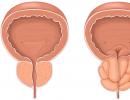Cleansing of the hypotonic gallbladder and bile ducts from stagnant bile
The cleansing of the gallbladder, which is for one reason or another in hypotonicity, is carried out according to the testimony of a doctor, since this procedure can be prescribed only after the exclusion of all possible contraindications and the selection of one or another technique. To perform the cleaning procedure, both non-invasive methods are used in the form of special exercises and the intake of choleretic agents of chemical or natural origin, as well as invasive methods performed using a probe.
In this article, we will introduce you to various methods of cleaning the gallbladder and its ducts, indications and contraindications for them, ways to perform and monitor the effectiveness of the procedure performed. This information will help you not to make mistakes that, when self-administering these procedures, can lead to such serious complications as obstructive jaundice, peritonitis, etc.
What is tyubazh and blind tyubazh?
Doctors call the methods of cleansing the gallbladder such terms as “tubage” or “blind tubage”. Translated from French, this word, unfamiliar to ordinary people, means such procedures as “probe insertion”, “intubation” or “tube insertion” into the lumen of an organ.
Varieties of tubage
- Tyubazh implies the implementation of such a medical procedure, which is accompanied by the introduction of a duodenal probe and drugs into the lumen of the duodenum, i.e. duodenal sounding.
- Blind tubazh carried out with the help of various means that promote the outflow of bile and reduce the muscle layer of the gallbladder: antispasmodic and choleretic drugs, a set of special therapeutic exercises, heating pads. They are administered orally, applied topically and are not accompanied by the introduction of a probe into the digestive tract.
Each of these methods has its advantages and disadvantages, indications and contraindications. Blind tubage can be carried out at home after the doctor thoroughly familiarizes and teaches the patient the technique of its implementation and selects for him the method of this method of cleansing the gallbladder and ducts, which will not harm his health. And the usual tubage is performed only in a clinic or hospital.
Is it necessary to cleanse the gallbladder and its ducts as a preventive measure for healthy people?
This question is increasingly being asked by people who care about their health. In recent years, recommendations about the need for regular "cleansing of the liver and gall" and advertising of various methods for "cleansing the bile ducts and liver" are increasingly found in the media and on Internet resources. Many of these pseudo-recommendations can be not only inappropriate, but also dangerous for some people with various chronic diseases.
In this regard, many therapists, gastroenterologists and specialists in other areas of medicine have begun to hear more and more questions from their patients about the advisability of performing such procedures. And in some cases, the illiterate implementation of such "methods for cleansing the liver and bile" becomes the reason for calling the ambulance team and the need for an urgent surgical operation.
Most gastroenterologists do not recommend tubage in the absence of or suspected biliary tract disease. This is due to the fact that in the absence of stagnation of bile, which leads to various other malfunctions in the functioning of the digestive organs, the gallbladder and its ducts do not need additional "cleaning".
Tyubazh
Tubage, or duodenal sounding, for therapeutic and diagnostic purposes, can be prescribed for various diseases of the gastrointestinal tract, which are accompanied by hypotension of the gallbladder and bile ducts. At its core, this procedure is the most effective for cleansing the gallbladder of bile that has stagnated in it, since it guarantees its almost complete excretion.
Indications
Indications for the appointment of this procedure may be such diseases and procedures:
- biliary dyskinesia with cholecystitis, which is not accompanied;
- chronic duodenitis;
- chronic pancreatitis;
- diagnostic microscopic or bacteriological examination of bile.
Contraindications
Like any medical procedure, tubage can be contraindicated if the patient has various concomitant diseases:
- narrowing of the esophagus;
- acute cholecystitis;
- exacerbation;
- acute gastritis, duodenitis and other acute inflammatory processes of the digestive tract at the initial stage;
- suffocation or with broncho-pulmonary pathologies;
- coronary insufficiency;
- esophageal carcinoma;
- or duodenal ulcer during an exacerbation or with a tendency to develop gastrointestinal bleeding;
- tendency to arterial hypertension in combination with the threat of stroke and other complications of vascular diseases;
How is the procedure performed?
 Tubage can be prescribed only by a doctor after a preliminary examination.
Tubage can be prescribed only by a doctor after a preliminary examination. Before setting the date for performing the gallbladder and ducts tubage, the doctor must prescribe to the patient a number of diagnostic studies that allow you to determine if the patient has possible contraindications to this procedure. Their number is determined after a thorough history of the patient and his examination.
The patient may be prescribed the following methods of examination:
- clinical blood and urine tests;
- Ultrasound of the liver, gallbladder and other abdominal organs;
- Fibrogastroduodenoscopy, etc.
To prepare for the tubage procedure, it is recommended to follow a diet that prevents flatulence for 2-3 days and take belladonna or Atropine 1-2 times a day. Before going to bed, you need to apply a heating pad. On the evening before the procedure, the patient should have a cleansing enema or take a saline laxative.
The procedure is carried out in the morning. On the day of probing, the patient should not eat or drink water, because when the probe is inserted into the esophagus, he may vomit, and the vomit may enter the respiratory tract.
The duodenal sounding procedure can be performed on an outpatient basis or in a hospital. It runs like this:
- The patient is seated on the couch and offered to take a few deep breaths and exhalations.
- The nurse performing the insertion of the probe explains to the patient how he should swallow the olive at the end of the probe.
- The olive is placed on the root of the tongue, and the patient performs several slow swallowing movements.
- Next, the nurse gently inserts the probe to the first mark and lays the patient on the couch on the right side, placing a roller and a heating pad under the right hypochondrium under the pelvis. After this, the pylorus opens between the stomach and duodenum. Sometimes, with pyloric spasm, the patient is suggested to take a 2% soda solution, which helps to eliminate spasms in the muscles of the stomach and duodenum, do a light massage of the upper abdomen, or inject a 0.1% solution of Atropine sulfate.
- After opening the pylorus, the patient continues to perform slow swallowing movements and swallows the probe to the second mark.
- The nurse sucks with a syringe attached to the other end of the probe, the contents and, by its nature, locates the olive. When the probe is inserted into the duodenum, a golden transparent liquid with an alkaline reaction is drawn into the syringe, which is determined using litmus paper.
- The outer end of the probe is lowered into tube A and the contents of the duodenum are collected in it.
- The patient is asked to lie on his back and a 33% Magnesia solution (warmed up to 40-42 ° C) is injected into the probe, which can cause the so-called "bubble reflex", contraction of the gallbladder walls and contraction of the sphincter of the common bile duct. A clamp is applied to the probe for 5-10 minutes.
- After that, the clamp is opened and the secreted portion of dark bile is collected in another test tube B.
- Following this portion of dark bile, a golden liquid begins to be released into the test tube, which is collected in the next, third test tube C.
- After the release of the golden liquid is complete, the probe is carefully removed.
- The tubes with the obtained bile are sent to the laboratory, where a quantitative, microscopic and bacteriological analysis of all three portions is carried out.
Sometimes patients with bowel diseases are recommended to introduce drugs into the duodenum before removing the probe. Your doctor may prescribe the following solutions:
After the completion of the tubage procedure, the patient's blood pressure and pulse are measured. If the procedure was performed in a hospital, then it is delivered to the ward. He can have breakfast there. The medical staff continues to monitor the patient's well-being.
If the tubage was carried out on an outpatient basis, then the patient is allowed to go home only after his state of health is completely stabilized - after about 40-60 minutes - and they are told the date and time for a visit to the doctor and evaluation of the results of laboratory tests.
Tubage results
After the completion of the tubage procedure, most patients with gallbladder diseases experience a feeling of relief in the right hypochondrium. They note that their digestion normalizes and painful and unpleasant sensations in the gallbladder area disappear.
Therapeutic tubage can be performed as follows: a course of procedures is carried out for 1.5 months with an interval between them of 5-7 days. If necessary, after 3-4 weeks, the course of therapeutic probing is repeated.
Blind tubazh
Blind tubage, or probing, can be performed using various techniques. The most suitable and effective of them should be selected by a doctor who can be guided by the data of diagnostic studies.
With mineral water and heating pad

To perform this method of blind tubage, it is recommended to use Essentuki-17, Borjomi alkaline mineral water. It is necessary to release gas from it, which can interfere with the effective cleansing of the gallbladder, and warm it to room temperature.
- Drink a glass of mineral water every 20 minutes. In this way, it is necessary to take at least 1.5-2 liters.
- Lie on your right side and put a warm heating pad under your right hypochondrium. Lie down for about 1.5-2 hours.
With Mineral Water and Xylitol
To perform this method of tubage, mineral water without gas and Xylitol or Magnesia dissolved in it are used (these drugs can be purchased at a pharmacy). Dissolve 1 teaspoon of one of these drugs in a glass of water.
- Drink a glass of mineral water with Magnesia or Xylitol.
- Lie on your right side and put a warm heating pad under your right hypochondrium. Lie down for about half an hour.
- Drink the remaining 1.5-2 liters of mineral water.
- Repeat the same procedure after 2 days.
With mineral water and raw egg yolks
To perform this method of tubage, Slavyanskaya mineral water without gas and raw egg yolks are used.
- Drink 2 yolks.
- Drink 0.5 liters of mineral water.
- Lie on your right side and place a warm heating pad under the liver area.
- Drink another 0.5 l of mineral water in small sips.
- After the urge to defecate, go to the toilet. Usually they appear immediately after taking all the mineral water.
The course of blind tubages is usually designed for 25 days, i.e., it involves the implementation of 10 procedures. These days it is necessary to stay at home, because the procedures cause a laxative effect.
In addition to these simple recommendations, one should not forget that for an effective procedure for cleaning the gallbladder and its ducts, the food taken should be sparing: not greasy, not spicy, not smoked, containing a sufficient amount of vitamins and minerals. On the days of performing blind tubage, it is recommended to follow a milk-vegetable diet and take a sufficient amount of liquid (water, choleretic teas or rosehip infusion).






